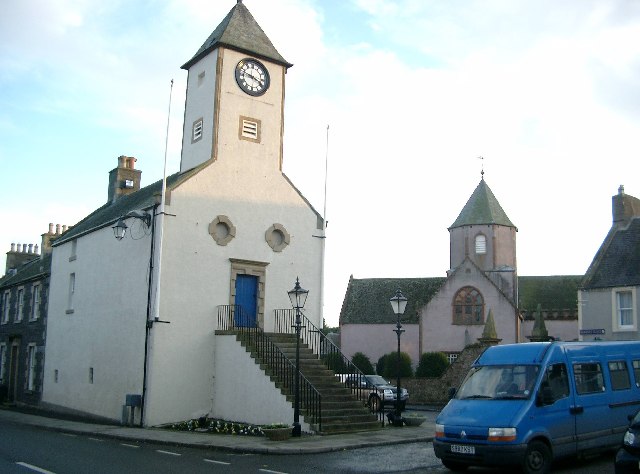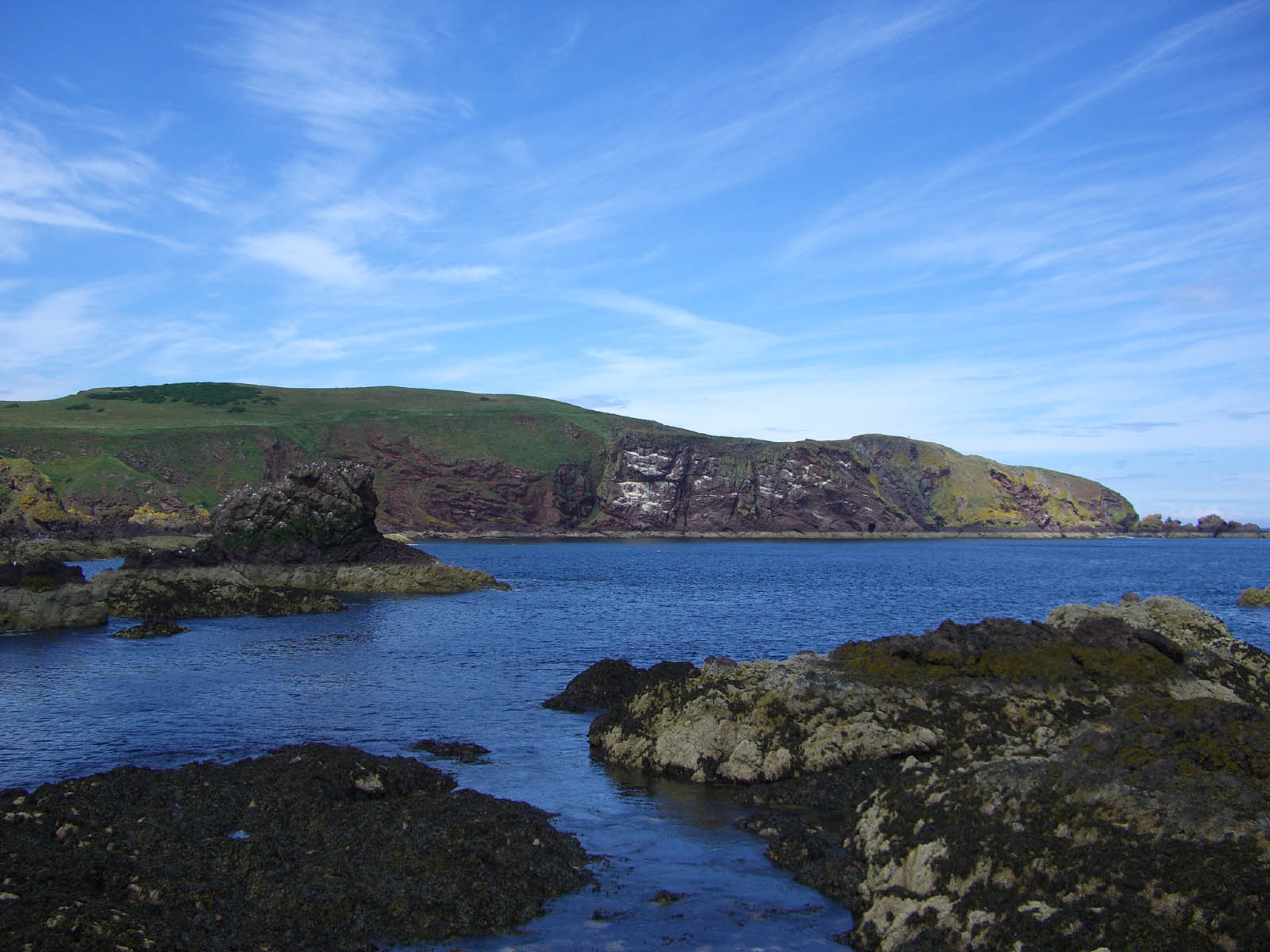|
Lauder Railway Station
Lauder railway station served the town of Lauder, Berwickshire, Scotland, from 1901 to 1958. It was situated on the Lauder Light Railway. History The station was opened on 2 July 1901 by the Lauder Light Railway. It was situated at the end of a short road from the A68. There were no lights leading up to the station on the road, which was an issue for people trying to find it in the dark. Despite this, neither the road nor the station ever had lights installed due to the high cost at the time. Like the preceding station at Oxton there was no signal box, just a ground frame. There was a goods yard to the east which had two sidings. On the east side of this was the goods shed, which was not served by rail. Nearby was a locomotive shed with one road. The station closed to passengers on 12 September 1932 but stayed open to goods. The locomotive shed was closed and quickly demolished. A food and flour depot with two sheds was built to the west during the Second World War ... [...More Info...] [...Related Items...] OR: [Wikipedia] [Google] [Baidu] |
North British Railway
The North British Railway was a British railway company, based in Edinburgh, Scotland. It was established in 1844, with the intention of linking with English railways at Berwick. The line opened in 1846, and from the outset the company followed a policy of expanding its geographical area, and competing with the Caledonian Railway in particular. In doing so it committed huge sums of money, and incurred shareholder disapproval that resulted in two chairmen leaving the company. Nonetheless the company successfully reached Carlisle, where it later made a partnership with the Midland Railway. It also linked from Edinburgh to Perth and Dundee, but for many years the journey involved a ferry crossing of the Forth and the Tay. Eventually the North British built the Tay Bridge, but the structure collapsed as a train was crossing in high wind. The company survived the setback and opened a second Tay Bridge, followed soon by the Forth Bridge, which together transformed the railway ne ... [...More Info...] [...Related Items...] OR: [Wikipedia] [Google] [Baidu] |
Lauder
The former Royal Burgh of Lauder (, gd, Labhdar) is a town in the Scottish Borders in the historic county of Berwickshire. On the Southern Upland Way, the burgh lies southeast of Edinburgh, on the western edge of the Lammermuir Hills. Etymology Although Lauder sits in the valley of Leader Water, Watson notes that the names Lauder and Leader appear to be unconnected. In the earliest sources Lauder appears as ''Lawedder'' and ''Loweder''. The name may be derived from the Brittonic ''lǭwadr'', meaning "washing or bathing place" (Breton ''laouer''). Or else, Lauder may be named from a word related to Middle Welsh ''llawedrawr'', "a heap of ruins". Medieval history Below Lauder are the lands of Kedslie which were bounded on the west by a road called "Malcolm's rode", and it is thought this formed part of the Roman road known as Dere Street, which passed through Lauder. Hardie suggests that it had been reconditioned by Malcolm III for use in his almost constant warfare against ... [...More Info...] [...Related Items...] OR: [Wikipedia] [Google] [Baidu] |
Berwickshire
Berwickshire ( gd, Siorrachd Bhearaig) is a historic county, registration county and lieutenancy area in south-eastern Scotland, on the English border. Berwickshire County Council existed from 1890 until 1975, when the area became part of the Borders region, with most of the historic county becoming part of the lower-tier Berwickshire district. Berwickshire district was abolished in 1996, when all the districts in the Borders region merged to become the Scottish Borders council area. The county takes its name from Berwick-upon-Tweed, its original county town, which was part of Scotland at the time of the county's formation in the twelfth century, but became part of England in 1482 after several centuries of swapping back and forth between the two kingdoms. After the loss of Berwick, Duns and Greenlaw both served as county town at different periods. The low-lying part of Berwickshire between the Tweed and the Lammermuirs is known as "the Merse", from an old Scots w ... [...More Info...] [...Related Items...] OR: [Wikipedia] [Google] [Baidu] |
Ordnance Survey National Grid
The Ordnance Survey National Grid reference system (OSGB) (also known as British National Grid (BNG)) is a system of geographic grid references used in Great Britain, distinct from latitude and longitude. The Ordnance Survey (OS) devised the national grid reference system, and it is heavily used in their survey data, and in maps based on those surveys, whether published by the Ordnance Survey or by commercial map producers. Grid references are also commonly quoted in other publications and data sources, such as guide books and government planning documents. A number of different systems exist that can provide grid references for locations within the British Isles: this article describes the system created solely for Great Britain and its outlying islands (including the Isle of Man); the Irish grid reference system was a similar system created by the Ordnance Survey of Ireland and the Ordnance Survey of Northern Ireland for the island of Ireland. The Universal Transverse ... [...More Info...] [...Related Items...] OR: [Wikipedia] [Google] [Baidu] |
Lauder Light Railway
The Lauder Light Railway was a railway line opened in 1901 to connect the remote agricultural settlement of Lauder in Berwickshire with the main line of the Waverley Route railway at Fountainhall. Traffic was never heavy and bus competition led to closure to passengers in 1932. Goods traffic might not have survived but a Food Buffer Depot (to provide emergency food rations in wartime) was established at Lauder during World War II and the rail-borne traffic sustained the line for some years. It closed finally in 1958 and little now remains, though bits of the formation, including embankments and cuttings, are visible at Middletoun. History First proposals In the nineteenth century Lauder was in a remote location; there was no industry other than agriculture. In 1846 the Berwickshire Central Railway was proposed, following the Lauder Railway route as actually built and continuing to Earlston and Kelso, but there was no support for the company and it collapsed. In 1848 the line wh ... [...More Info...] [...Related Items...] OR: [Wikipedia] [Google] [Baidu] |
London And North Eastern Railway
The London and North Eastern Railway (LNER) was the second largest (after LMS) of the "Big Four" railway companies created by the Railways Act 1921 in Britain. It operated from 1 January 1923 until nationalisation on 1 January 1948. At that time, it was divided into the new British Railways' Eastern Region, North Eastern Region, and partially the Scottish Region. History The company was the second largest created by the Railways Act 1921. The principal constituents of the LNER were: * Great Eastern Railway * Great Central Railway * Great Northern Railway * Great North of Scotland Railway * Hull and Barnsley Railway * North British Railway * North Eastern Railway The total route mileage was . The North Eastern Railway had the largest route mileage of , whilst the Hull and Barnsley Railway was . It covered the area north and east of London. It included the East Coast Main Line from London to Edinburgh via York and Newcastle upon Tyne and the routes from Edinburgh ... [...More Info...] [...Related Items...] OR: [Wikipedia] [Google] [Baidu] |
Oxton, Scottish Borders
Oxton is a small rural village in the Scottish Borders area of Scotland, just off the A68. It is north of Lauder, and southeast of the centre of Edinburgh, yet in a quiet rural position. History The village of Oxton lies in the parish of Channelkirk. This name for the parish appears to have come into general use in the district around the beginning of the eighteenth century but its ancient name was Childer-kirk and later Gingle-kirk. A Roman camp, visible from the air, and recorded on Ordnance survey maps has been identified nearby and may have been connected with the progress of the army of Septimius Severus in AD 209–210. Saint Cuthbert, who became Bishop of Lindisfarne, was born in the vicinity in AD 635, and probably baptised his early converts at the nearby Holy Water Cleuch (spring). The village Oxton was called Ugston for several hundred years and appears under that name as late as the 1841 census. As with all Scottish parishes its inhabitants were ruled by a combi ... [...More Info...] [...Related Items...] OR: [Wikipedia] [Google] [Baidu] |
Second World War
World War II or the Second World War, often abbreviated as WWII or WW2, was a world war that lasted from 1939 to 1945. It involved the World War II by country, vast majority of the world's countries—including all of the great powers—forming two opposing military alliances: the Allies of World War II, Allies and the Axis powers. World War II was a total war that directly involved more than 100 million Military personnel, personnel from more than 30 countries. The major participants in the war threw their entire economic, industrial, and scientific capabilities behind the war effort, blurring the distinction between civilian and military resources. Air warfare of World War II, Aircraft played a major role in the conflict, enabling the strategic bombing of population centres and deploying the Atomic bombings of Hiroshima and Nagasaki, only two nuclear weapons ever used in war. World War II was by far the List of wars by death toll, deadliest conflict in hu ... [...More Info...] [...Related Items...] OR: [Wikipedia] [Google] [Baidu] |
Railway Stations In Great Britain Opened In 1901
Rail transport (also known as train transport) is a means of transport that transfers passengers and goods on wheeled vehicles running on rails, which are incorporated in tracks. In contrast to road transport, where the vehicles run on a prepared flat surface, rail vehicles (rolling stock) are directionally guided by the tracks on which they run. Tracks usually consist of steel rails, installed on sleepers (ties) set in ballast, on which the rolling stock, usually fitted with metal wheels, moves. Other variations are also possible, such as "slab track", in which the rails are fastened to a concrete foundation resting on a prepared subsurface. Rolling stock in a rail transport system generally encounters lower frictional resistance than rubber-tyred road vehicles, so passenger and freight cars (carriages and wagons) can be coupled into longer trains. The operation is carried out by a railway company, providing transport between train stations or freight customer facili ... [...More Info...] [...Related Items...] OR: [Wikipedia] [Google] [Baidu] |
1901 Establishments In Scotland
Nineteen or 19 may refer to: * 19 (number), the natural number following 18 and preceding 20 * one of the years 19 BC, AD 19, 1919, 2019 Films * ''19'' (film), a 2001 Japanese film * ''Nineteen'' (film), a 1987 science fiction film Music * 19 (band), a Japanese pop music duo Albums * ''19'' (Adele album), 2008 * ''19'', a 2003 album by Alsou * ''19'', a 2006 album by Evan Yo * ''19'', a 2018 album by MHD * ''19'', one half of the double album '' 63/19'' by Kool A.D. * '' Number Nineteen'', a 1971 album by American jazz pianist Mal Waldron * ''XIX'' (EP), a 2019 EP by 1the9 Songs * "19" (song), a 1985 song by British musician Paul Hardcastle. * "Nineteen", a song by Bad4Good from the 1992 album ''Refugee A refugee, conventionally speaking, is a displaced person who has crossed national borders and who cannot or is unwilling to return home due to well-founded fear of persecution. [...More Info...] [...Related Items...] OR: [Wikipedia] [Google] [Baidu] |






